Common degu
| Common degu | |
|---|---|

| |
| AtHeidelberg Zoo,Germany | |
| Scientific classification | |
| Domain: | Eukaryota |
| Kingdom: | Animalia |
| Phylum: | Chordata |
| Class: | Mammalia |
| Order: | Rodentia |
| Family: | Octodontidae |
| Genus: | Octodon |
| Species: | O. degus
|
| Binomial name | |
| Octodon degus (Molina,1782)
| |
| Synonyms | |
|
Sciurus degusMolina, 1782 | |
Thecommon degu(Octodon degus;/ˈdeɪɡuː/), or, historically, thedegu,is a smallhystricomorpharodentendemicto theChilean matorralecoregionofcentral Chile.[2]The namedeguon its own indicates either the entire genusOctodonor, more commonly, just the common degu. Common degus belong to theparvorderCaviomorphaof theinfraorderHystricognathi,along with thechinchillaandguinea pig.The worddegucomes from the indigenous language of Chile,Mapudungun,and the worddewü,meaning 'mouse' or 'rat'.[3]
The animal may be kept as a domestic pet, though there are prohibitions on their ownership in some territories. As a pet, the animal is larger than agolden hamsterbut smaller than afancy rat.
Description
[edit]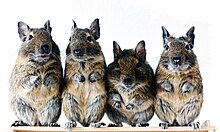

The common degu is a small animal with a body length of 25.0 to 31.0 cm (9.8–12.2 in) and a weight of 170 to 400 g (6.0 to 14.1 oz). It has yellow-brown fur above and creamy-yellow below, with yellow around the eyes and a paler band around the neck. It has a long, thin tail with a tufted, black tip, dark sparsely furred ears, and pale grey toes. Its fifth toe is small with a nail, rather than a claw, on the fore feet. Its hind feet are bristled. Its cheek teeth are shaped like figures-of-eight, hence the degu'sgenusnameOctodon.[4]
Social behavior
[edit]
Common degus are highly social. They live in burrows, and, by digging communally, they are able to construct larger and more elaborate burrows than they could on their own.[5]Degus digging together coordinate their activities, forming digging chains.[6]Females living in the same group have been shown to spontaneously nest communally;[7][8]they nurse one another's young. They spend a large amount of time on the surface, where they forage for food.[6]When foraging, their ability to detect predators is increased in larger groups,[9]and each animal needs to spend less time invigilance.
Common degus exhibit a wide array of communication techniques. They have an elaborate vocal repertoire comprising up to 15 different sounds,[10]and the young need to be able to hear their mother's calls if the emotional systems in their brains are to develop properly.[11]They use theirurinetoscent mark,[12]and experiments have shown that they react to one another's marks,[13]although in males the hormonetestosteronemay suppress their sense of smell somewhat.[14]
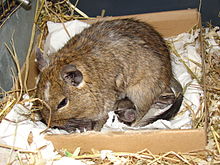
Common degus are seasonal breeders; the breeding season for wild degus begins in the Chilean autumn when day and night are roughly equal,[15]with pups born in early to mid-spring.[16]Female degus are pregnant for approximately ninety days,[4][17]having a comparatively long gestation period compared to other non-caviomorph rodents. Female pregnant weight varies over the course of gestation and according to litter size;[18]litters contain an average of six pups,[7]but size can range from one or two up to twelve young.[18]Common degu pups are born relativelyprecocial,fully furred and with eyes open, and theirauditoryandvisual systemsare functional at birth.[19]Unlike most other rodents, male common degus also take part in protecting and raising their pups until they are old enough to leave the family.[20]
Unlike some otheroctodontids,common degus arediurnal[21](active during the day), and they have good vision. Theirretinasincluderod cellsand two types ofcone cells,corresponding to peak sensitivity in the green andultravioletregions of thespectrum.[22]Behavioral experiments have shown that degus are able to discriminate ultraviolet light from the wavelengths visible to humans; it is likely that this ultraviolet sensitivity has a social function, since both theirventral(stomach) fur and theirurineare highly UV reflective.[23]
Diet
[edit]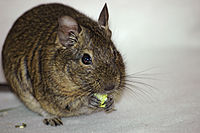
Common degus are strictlyherbivorous,in the wild feeding on grasses and browsing the leaves of shrubs, though they will also take seeds.[24]Throughout much of the year forage is dried[21]and so common degus are specially adapted to a very high fibre intake,[25]and this varies between food types and environmental conditions.[26]Like some other herbivores such asrabbits,they performcoprophagy(faecalreingestion) so as to extract more nutrition from their diet.[27]This also serves to maintain healthy gut function during times when food is scarce.[27]Although they are active by day, in high summer they do not leave their burrows in the middle of the day[21]and instead emerge to forage in the mornings and evenings.
Perhaps the most remarkable feature of common degu physiology is their intolerance of dietary sugar. Common degus have been found to have a divergentinsulinstructure (one of the hormones that regulateblood glucose level) and so are highly susceptible to developingdiabetes mellituswhen fed regularly on a diet containing free sugars.[28]This is thought to be due to evolutionary pressure arising from the lack of availability of free sugars in the degu's natural environment.[29]Because of this, the ingredients of non-degu-specific hard feed formulations given to captive common degus should be checked for sugar-laden ingredients, such asmolasses,honey,andglucose syrup.[citation needed]
Research subjects
[edit]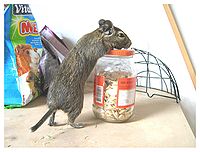
Common degus entered the research spotlight due to their unique relationship with sugar and diabetes, but are also studied for a wide variety of other reasons. Neuroscientistsat theRiken InstituteinTokyo,Japan,used common degus for research into tool use in animals with good eye-and-paw coordination, in which they spontaneously learned to use a tiny rake to retrieve out-of-reach seeds.[30]Common degus have also been found to spontaneously stack objects in order of decreasing size.[31]In both cases it is the first time these behaviours have been recorded in animals other than apes and birds.[citation needed]
Another interesting area of common degu research iscircadian rhythmfunction, i.e. the ability of the brain to tell what time of day it is. Degus have the ability to show bothdiurnalandnocturnalrhythms if the environment permits,[32]allowing a unique opportunity for study. Common degus can take cues that do not relate to day length, such as temperature,[33]melatoninlevels[34]and even scents from other degus[35]to adjust their rhythms.
Common degus are also invaluable in development and aging studies. Research has shown thatseparation anxietycaused by separating pups from their mother from an early age for periods of half an hour or more can cause developmental and behavioural changes in later life, similar toADHDin humans.[36]In elderly common degus,neuralmarkers have been discovered which are remarkably similar to those in humans withAlzheimer's disease,which is the first time this has been seen in a wild-type rodent.[37]
As pets
[edit]
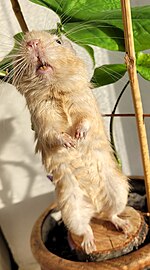
After initial interest into common degus asresearch subjects,they have become popular aspets,though until recently[when?]they were seldom found in pet shops. Their advantages over traditional small pets are theirdiurnalhabits, bubbly personalities, the haired tail (as compared toratsandmice) and their lifespan: they are reported to live up to 13 years under ideal circumstances (though a poor gene pool or genetic background often reduces a pet degu's lifespan significantly).[citation needed]The average lifespan of a common degu in captivity is typically around six to eight years of age.
One disadvantage of the common degu as a pet is their predisposition to chewing, due to their continually growing incisor and molar teeth.[4]For this reason, common degus cannot be housed in plastic-bottomed cages typically found in pet stores. A metal cage with multiple levels made for rats and secured double latches works best. It is important to line the levels with grass mats or a soft fabric so that the common degus do not getbumblefoot.[citation needed]
Untamed common degus, as with some other small animals kept as pets, can be prone to biting, but their intelligence makes them easy to tame. Regular non-predatory handling and food offerings help with this transition. It is important to never try to catch a common degu by the tail because the skin and tuft at the end is easily "shed" (pulled off). This helps common degus in the wild elude capture by predators, but it is painful to the creature and the tail end will not grow back. When tail shedding occurs, common degus will chew off the damaged portion. This can reduce the chances of infection.[citation needed]
Common degus often "groom" their human owners with a gentle nibbling action, and readily bond with any person spending time with them. Common degus need regularsand baths,like Chinchillas need dust baths, to keep their coats healthy and free from grease.Chinchillasand is ideal for this. They should have access to these baths regularly, preferably two or three times a week for half an hour at a time. However, daily sand bathing can make their coats soiled.[citation needed]
Prohibitions
[edit]Some jurisdictions consider common degus as a potentialinvasive speciesand forbid owning them as a pet.
In the United States, they are illegal to own inCalifornia,[38]Utah,[39]Georgia,Connecticut,[40]andAlaska.[41]
Gallery
[edit]-
Common degus in captivity
-
Two common degus outside
-
Baby common degus nursing
-
Adult common degu perched on a platform
-
Two common degus
-
Common degu scratching
-
Three common degu pups, eight days old
-
Two young common degus
-
Common degu performing a trick
-
Newborn common degu (1 day old)
-
Mother nursing newborn pups
-
Curious adults in a wooden cage
-
Degu with blue coat, a common colour variation
See also
[edit]References
[edit]- ^Roach, N. (2016)."Octodon degus".IUCN Red List of Threatened Species.2016:e.T15088A78321302.doi:10.2305/IUCN.UK.2016-2.RLTS.T15088A78321302.en.Retrieved19 November2021.
- ^C. Michael Hogan & World Wildlife Fund. 2013. Chilean Matorral. Ed. Mark McGinley. Encyclopedia of Earth. National Council for Science and the Environment. Washington DC
- ^Muñoz Urrutia, Rafael, ed. (2006),Diccionario Mapuche: Mapudungun/Español, Español/Mapudungun(in Spanish) (2nd ed.), Santiago, Chile: Editorial Centro Gráfico, pp. 104, 105, 141,ISBN978-956-8287-99-3
- ^abcWoods, C.; Boraker, D. (21 November 1975),"Octodon degus"(PDF),Mammalian Species(67): 1–5,doi:10.2307/3503820,JSTOR3503820,S2CID253992625
- ^Ebensperger, L. A.; Bozinovic, F. (2000), "Communal burrowing in the hystricognath rodent,Octodon degus:A benefit of sociality? ",Behavioural and Ecological Sociobiology,47(5): 365–369,doi:10.1007/s002650050678,hdl:10533/172245,ISSN0340-5443,S2CID12859012
- ^abEbensperger, L. A.; Bozinovic, F. (2000b), "Energetics and burrowing behaviour in the semifossorial deguOctodon degus(Rodentia: Octodontidae) ",Journal of Zoology,252(2): 179–186,doi:10.1111/j.1469-7998.2000.tb00613.x,hdl:10533/172199
- ^abEbensperger, L.A.; Veloso, C.; Wallem, P. (2002), "Do female degus communally nest and nurse their pups?",Journal of Ethology,20(2): 143–146,doi:10.1007/s10164-002-0063-x,ISSN0289-0771,S2CID38854503
- ^Ebensperger, L.A.; Hurtado, M.; Lacey, E.; Chang, A.; Chang, AT (2004), "Communal nesting and kinship in degus (Octodon degus) ",Naturwissenschaften,91(8): 391–395,Bibcode:2004NW.....91..391E,doi:10.1007/s00114-004-0545-5,hdl:10533/175502,ISSN0028-1042,PMID15309311,S2CID929721
- ^Quirici, V.; Castro, R.A.; Oyarzun, J.; Ebensperger, L.A. (2008), "Female degus (Octodon degus) monitor their environment while foraging socially ",Anim Cogn,11(3): 441–448,doi:10.1007/s10071-007-0134-z,ISSN1435-9448,PMID18214556,S2CID17723026
- ^Long, C.V. (2007), "Vocalisations of the degu (Octodon degus), a social caviomorph rodent ",Bioacoustics,16(3): 223–244,doi:10.1080/09524622.2007.9753579,ISSN0952-4622,S2CID84569309
- ^Ziabreva, I.; Schnabel, R.; Poeggel, G.; Braun, K. (2003), "Mother's voice" buffers "separation-induced receptor changes in the prefrontal cortex ofOctodon degus",Neuroscience,119(2): 433–441,doi:10.1016/S0306-4522(03)00123-4,PMID12770557,S2CID28635328
- ^Kleiman, D.G. (1974), "Patterns of behaviour in hystricomorph rodents", in Rowlands, I. W.; Weir, B. J. (eds.),The Biology of Hystricomorph Rodents,London: Academic Press,LCCN74005683
- ^Fischer, R.; Meunier, G. (1985), "Responses to conspecifics' urine by the deguOctodon degus",Physiological Behaviour,34(6): 999–1001,doi:10.1016/0031-9384(85)90027-7,PMID4059390,S2CID27846946
- ^Jechura, T.; Walsh, J.; Lee, T. (2003), "Testosterone suppresses circadian responsiveness to social cues in the diurnal rodentOctodon degus",Journal of Biological Rhythms,18(1): 43–50,doi:10.1177/0748730402239675,PMID12568243,S2CID40262270
- ^Ebensperger, L.A.; Caiozzi, A. (2002), "Male degus,Octodon degus,modify their dustbathing behaviour in response to social familiarity of previous dustbathing marks ",Revista Chilena de Historia Natural,75:157–163,doi:10.4067/S0716-078X2002000100015,ISSN0716-078X
- ^Bozinovic, F.; Bacigalupe, L.; Vasquez, R.; Visser, H.; Veloso, C.; Kenagy, G. (2004), "Cost of living in free-ranging degus (Octodon degus): Seasonal dynamics of energy expenditure ",Comparative Biochemistry and Physiology A,137(3): 597–604,doi:10.1016/j.cbpb.2003.11.014,PMID15123196
- ^Brown, C.; Donnelly, T. (2001), "Cataracts and reduced fertility in degus (Octodon degus): Contracts secondary to diabetes mellitus ",Lab Animal,30:25–26,ISSN0093-7355
- ^abLong, C.V.; Ebensperger, L.A. (2009), "Pup growth rates and breeding female weight changes in two populations of captive bred degus (Octodon degus), a precocial caviomorph rodent ",Reprod Domest Anim.,45(6): 975–82,doi:10.1111/j.1439-0531.2009.01470.x,ISSN0936-6768,PMID19497026
- ^Reynolds, T.; Wright, J. (1979), "Early postnatal physical and behavioural development of degus (Octodon degus) ",Lab Animal,13(2): 93–9,doi:10.1258/002367779780943576,PMID480906,S2CID22769488
- ^"Breeding Degus".Exoticnutrition.Retrieved20 May2019.
- ^abcKenagy, G.; Nespolo, R.; Vasquez, R.; Bozinovic, F. (2002), "Daily and seasonal limits of time and temperature to activity of degus",Revista Chilena de Historia Natural,75(3): 567–581,doi:10.4067/S0716-078X2002000300008,ISSN0716-078X
- ^Cha'vez, A.; Bozinovic, F.; Peich, F.; Palacios, A. (2003), "Retinal spectral sensitivity, fur coloration and urine reflectance in the genusOctodon(Rodentia): Implications for visual ecology ",Investigative Ophthalmology & Visual Science,44(5): 2290–2296,doi:10.1167/iovs.02-0670,PMID12714673
- ^Palacios, A.; Bozinovic, F. (2003), "An" enactive "approach to ingtegrative and comparative biology: Thoughts on the table",Biol. Res.,36(1): 101–105,doi:10.4067/S0716-97602003000100008,ISSN0716-9760,PMID12795209
- ^Bozinovic, F.; Gallardo, P.A.; Visser, G.H.; Cortés, A. (2003), "Seasonal acclimatization in water flux rate, urine osmolality and kidney water channels in free-living degus: Molecular mechanisms, physiological processes and ecological implications",J Exp Biol,206(Pt 17): 2959–2966,doi:10.1242/jeb.00509,PMID12878664
- ^Langer, P. (2002), "The digestive tract and life history of small mammals",Mammal Review,32(2): 107–131,doi:10.1046/j.1365-2907.2002.00101.x
- ^Gutiérrez, J.; Bozinovic, F. (1998), "Diet selection in captivity by a generalist herbivorous rodent (Octodon degus) from the Chilean coastal desert ",Journal of Arid Environments,39(4): 601–607,Bibcode:1998JArEn..39..601G,doi:10.1006/jare.1998.0412
- ^abKenagy, G.; Veloso, C.; Bozinovic, F. (1999), "Daily rhythms of food intake and feces reingestion in the degu, an herbivorous Chilean rodent: Optimizing digestion through coprophagy",Physiological and Biochemical Zoology,72(1): 78–86,doi:10.1086/316644,PMID9882606,S2CID32432487
- ^Opazo, J.C.; Soto-Gamboa, M.; Bozinovic, F. (2004). "Blood glucose concentration in caviomorph rodents".Comp. Biochem. Physiol. A.137(1): 57–64.doi:10.1016/j.cbpb.2003.09.007.PMID14720591.
- ^Nishi, M.; Steiner, D. (2003)."Cloning of complementary DNA's encoding islet amyloid polypeptide, insulin, and glucagon precursors from a New World rodent, the degu,Octodon degus".Molecular Endocrinology.4(8): 1192–8.doi:10.1210/mend-4-8-1192.PMID2293024.
- ^abOkanoya, K.; Tokimoto, N.; Kumazawa, N.; Hihara, S.; Iriki, A.; Ferrari, Pier Francesco (2008), Ferrari, Pier Francesco (ed.), "Tool-Use Training in a Species of Rodent: The Emergence of an Optimal Motor Strategy and Functional Understanding",PLOS ONE,3(3): e1860,Bibcode:2008PLoSO...3.1860O,doi:10.1371/journal.pone.0001860,PMC2268009,PMID18365015
- ^Tokimoto, N.; Okanoya, K. (2004), "Spontaneous construction of" Chinese boxes "by degus (Octodon degus): A rudiment of recursive intelligence? ",Japanese Psychological Research,46(3): 255–261,doi:10.1111/j.1468-5584.2004.00257.x
- ^Kas, M. J. H.; Edgar, D. M. (2000), "Photic phase response curve inOctodon degus:Assessment as a function of activity phase preference ",American Journal of Physiology,278(5): R1385–1389,doi:10.1152/ajpregu.2000.278.5.R1385,PMID10801311,S2CID18503215
- ^Kas, M.J.; Edgar, D.M. (1998), "Crepuscular rhythms of EEG sleep-wake in a hystricomorph rodent,Octodon degus",J. Biol. Rhythms,13(1): 9–17,doi:10.1177/074873098128999871,PMID9486839,S2CID32894633
- ^Morris, L.G.; Tate, B.L. (2007), "Phase response curve to melatonin in a putatively diurnal rodent,Octodon degus",Chronobiol. Int.,24(3): 407–411,doi:10.1080/07420520701420352,PMID17612940,S2CID13223071
- ^Jechura, T.J.; Mahoney, M.M.; Stimpson, C.D.; Lee, T.M. (2006), "Odor-specific effects on reentrainment following phase advances in the diurnal rodent,Octodon degus",Am. J. Physiol. Regul. Integr. Comp. Physiol.,291(6): R1808–1816,doi:10.1152/ajpregu.00005.2006,ISSN0363-6119,PMID16840658,S2CID7354002
- ^Zehle, S.; Bock, J.; Jezierski, G.; Gruss, M.; Braun, K. (2007), "Methylphenidate treatment recovers stress-induced elevated dendritic spine densities in the rodent dorsal anterior cingulate cortex",Dev. Neurobiol.,67(14): 1891–1900,doi:10.1002/dneu.20543,PMID17874461,S2CID25698865
- ^Inestrosa, N.C.; Reyes, A.E.; Chacon, M.A.; Cerpa, W.; Villalon, A.; Montiel, J.; Merabachvili, G.; Aldunate, R.; et al. (2004), "Human-like rodent amyloid-beta-peptide determines Alzheimer pathology in aged wild-typeOctodon degus",Neurobiol. Aging,26(7): 1023–8,doi:10.1016/j.neurobiolaging.2004.09.016,PMID15748782,S2CID29644857
- ^CDFW, California Department of Fish and Wildlife (2018)."Why can't I have a [...] in California?".Wildlife.ca.gov.Retrieved2019-04-11.
- ^"UT Admin Code R657-3. Collection, Importation, Transportation, and Possession of Animals. April 1, 2019".Rules.utah.gov.Retrieved20 May2019.
- ^"Regulations of Connecticut State Agencies: TITLE 26. Fisheries & Game".Eregulations.ct.gov.Retrieved20 May2019.
- ^"10 Facts That Make Degus The Coolest Pet Ever!".Animalhub.6 March 2016.Retrieved20 May2019.














